Author: Tanay Ved Source: Coin Metrics Translation: Shan Ouba, Jinse Finance
Key Takeaways
• Miner revenue stabilizes after the halving, but transaction fees remain low, putting pressure on long-term incentives. Mining companies continue to adapt, investing in efficient hardware and utilizing renewable energy.
• Bitmain ASIC devices account for a major share of the Bitcoin network’s computing power, raising concerns about supply chain risks and geopolitical disruptions.
• Bitcoin is gradually evolving into a store of value, but efforts to expand its transactional use, including through Layer-2 solutions, continue.
• As block rewards decrease, maintaining miner incentives may require higher value transactions and drive block space demand through competition to generate significant transaction fee revenue.
introduction
Nearly a year after Bitcoin’s fourth halving, miners are going through an adaptation period to cope with reduced block rewards, narrowing profit margins, and changes in the way they operate. In this article, we update the Bitcoin mining ecosystem, including miner revenue, exchange fund flows, and ASIC hardware distribution. At the same time, we explore Bitcoin’s current use case - whether as a medium of exchange or a store of value - and the impact this has on miner incentives and the long-term sustainability of the network.
Mining Latest News
Miners’ income and capital flow
In the fourth quarter of 2024, miners' total revenue (including transaction fees and new block rewards) reached US$3.7 billion , an increase of 42% from the third quarter of 2024. In the third quarter, miners faced the challenges of halving block rewards, low Bitcoin prices, and rising energy costs, and were forced to improve mining efficiency.
As of the first quarter of 2025, miners' total revenue was approximately US$3.6 billion , of which transaction fees accounted for only 1.33% , and the 30-day average computing power had risen to 807 EH/s .
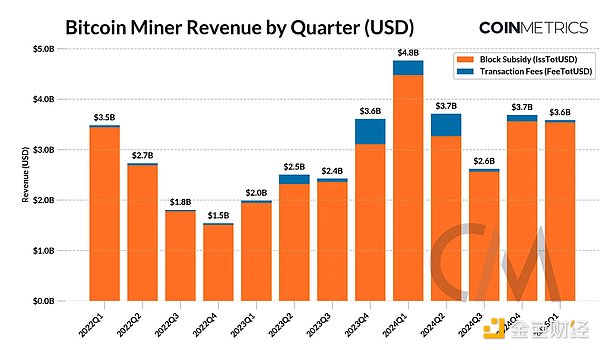
Miners' fund flow strategies are constantly adjusting. Data shows that 0-hop inflows from miners directly transferring funds to exchanges have remained basically stable , but there are occasional large sell-offs, indicating that mining companies are conducting stable fund management. The gradual increase in 1-hop inflows (miners transferring funds to exchanges through intermediate addresses) may reflect continued selling pressure from smaller miners or mining pool members.
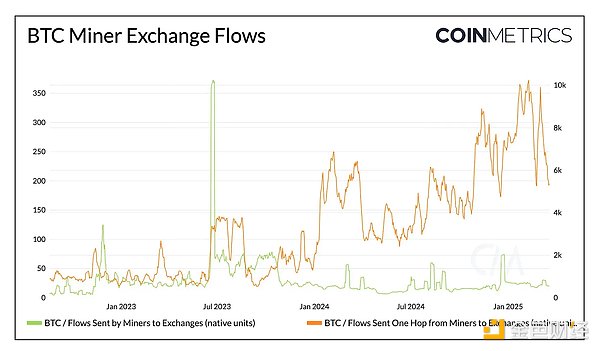
Evolution of Miner Strategies
Well-funded miners are better able to cope with the decline in revenue brought about by the halving, and they are adopting a variety of strategies to adapt, such as upgrading to more energy-efficient ASIC equipment to improve mining efficiency per unit of electricity. Migrate to areas with lower energy costs , such as wind farms in Texas, or energy-underutilized areas such as Africa and Latin America to reduce operating costs. Diversification , some mining companies have begun to get involved in AI data center hosting business to expand their sources of income. For example, Core Scientific has pledged to provide 200 megawatts of computing capacity to host CoreWeave's AI computing tasks. This shows that mining companies are transforming existing infrastructure into high-performance computing centers to increase profitability per unit of computing power.
Bitmain’s hardware dominance and geopolitical influence
While the geographic distribution of Bitcoin mining and the distribution of mining pool computing power are critical to the network's risk resistance, the supply of ASIC hardware is also a factor that cannot be ignored. While economic incentives and energy costs have prompted miners to disperse around the world, the geopolitical environment has brought additional challenges to the hardware supply chain.
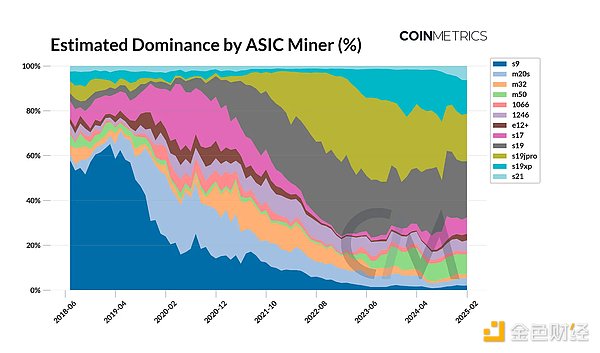
Based on the matching analysis of Nonce patterns with known ASIC devices , we estimate that mining machines produced by Bitmain (such as S19, S19j Pro, S19 XP) currently account for 59% to 76% of the Bitcoin network computing power. This data is based on multiple levels of calculations, including minimum estimates, adjusted data, and fully processed data sets.
Bitmain dominates the Bitcoin mining hardware market, and this reliance on a single manufacturer is a potential risk even with a distributed supply chain . As Bitmain is headquartered in China , its market dominance highlights the impact that geopolitical factors may have on mining stability. For example:
• In early 2025 , a number of U.S. miners encountered delays in the delivery of Bitmain mining machines due to strict customs inspections and new tariffs .
• While these delays vary in impact, they highlight the friction that the geopolitical environment can bring to the global mining industry and could reshape the industry landscape .
Current Use of Bitcoin
As mining competition intensifies and transaction fee revenue becomes more important, understanding the actual use of Bitcoin helps assess the sustainability of its network and the incentive mechanism for miners. Although Bitcoin was originally intended to be a "peer-to-peer electronic cash system", its use is gradually shifting to a global store of value and reserve asset.
Lightning Network and Bitcoin Layer-2 Ecosystem
In order to improve Bitcoin's transaction function and deal with scalability limitations and unstable transaction fees, second-layer solutions such as the Lightning Network came into being. The Lightning Network enables near-instant, low-cost transactions by creating off-chain payment channels between users, and only returns to the Bitcoin mainnet for settlement when the channel is closed.
Recently, the number of open lightning channels has dropped to about 52,700 , but the total value of channels remains between 4,500-5,000 BTC . This shows that despite the reduction in the number of channels, the network is still able to maintain the same value flow, possibly due to improved routing efficiency, channel merging, and the growth of private channels .
In addition, Bitcoin Rollups and sidechains such as Stacks and Botanix are under development to improve scalability and transaction activity, and ultimately drive growth in Bitcoin transaction fee revenue. These solutions hope to improve the practicality of the Bitcoin main chain while ensuring its security by introducing smart contracts, speeding up transactions, and expanding new use cases .

It is worth noting that low-value transactions on the Bitcoin network have grown . Transactions with amounts below $100 currently account for about 60% and even reach 80% at certain times in 2024. Although the number of large transactions of $100,000-1 million has also increased, their share of overall transactions has decreased relatively.

Currently, Bitcoin blocks have been continuously filled to the 4MB cap , despite relatively low mempool size and transaction counts . This suggests that block space is primarily filled with low-value, low-fee transactions , with less competition, resulting in low average transaction fees, with only brief spikes when demand for Ordinals and Runes surges. In the future, if participation in high-value or time-sensitive transactions increases, it may enhance transaction fee revenue, thereby supporting miner incentives and offsetting the impact of reduced block rewards.
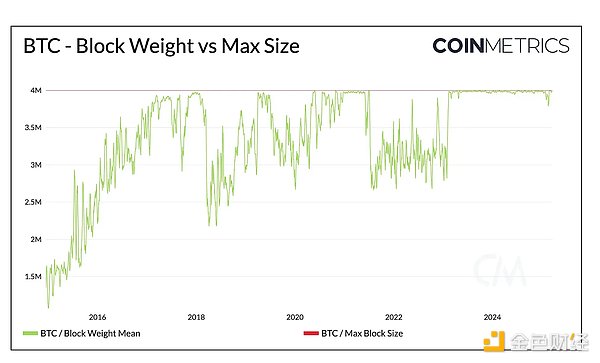
Bitcoin as a store of value and reserve asset
Although Bitcoin's transaction function is still being optimized, its role as a "store of value" is becoming more and more obvious. Its scarcity and predictable issuance mechanism have earned it the title of "digital gold" . This trend has accelerated in the past few years, with institutional investors, public companies, ETFs and even national entities holding increasing positions, and currently such entities hold more than 14% of the Bitcoin supply .
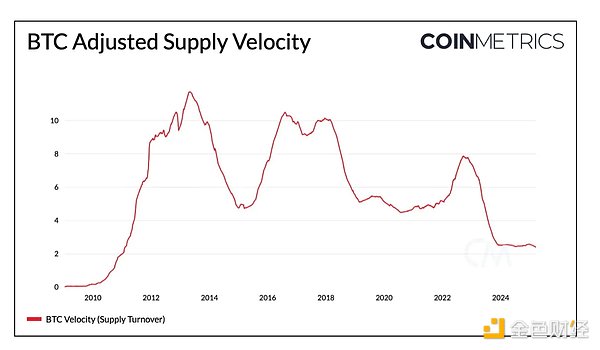
On-chain data also supports Bitcoin’s shift toward long-term holdings. The decline in Bitcoin supply liquidity , or the ratio of adjusted transfer volume to current supply, suggests that BTC is more likely to be held for the long term rather than traded frequently .
In addition, HODL Waves (Bitcoin holding time distribution) shows that the proportion of Bitcoin supply held for 1 year or more has risen to 63% . This figure continues to grow, reflecting that Bitcoin is evolving into a long-term reserve asset.
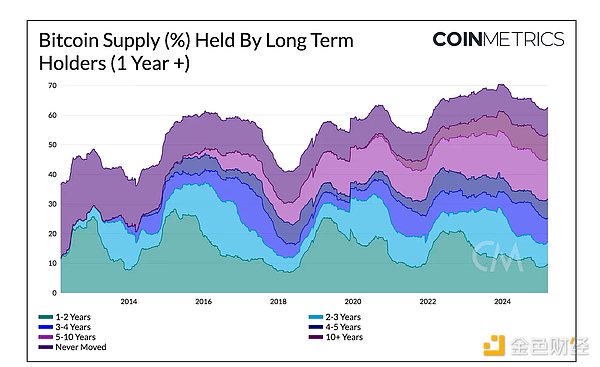
in conclusion
As miners adapt to the reality of reduced block rewards, they are optimizing their operations through hardware upgrades, geographic migration, and diversification . At the same time, the use of Bitcoin is also evolving: low-value transactions and Layer-2 activities are growing, while long-term holding is becoming more dominant , further consolidating its role as a store of value tool .
How to balance the transaction function and value storage attribute of Bitcoin will become the key to maintaining the long-term healthy development of the network and the sustainability of the security economic model in the future.






